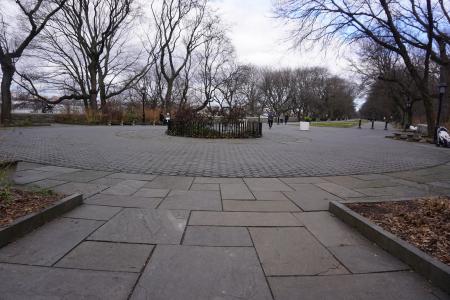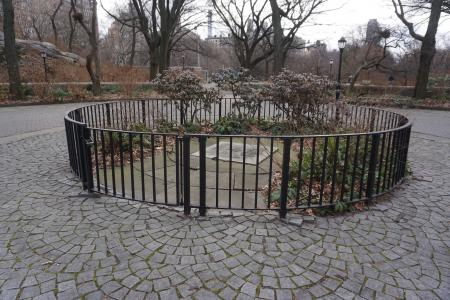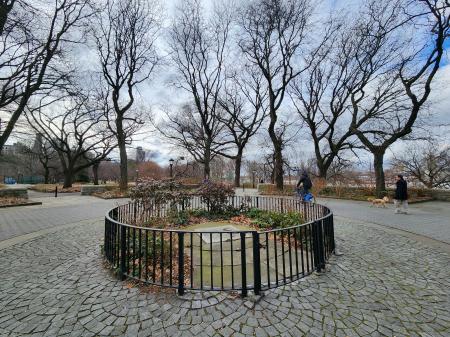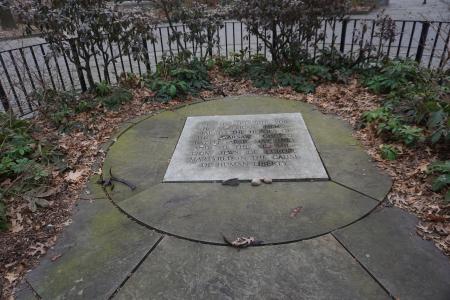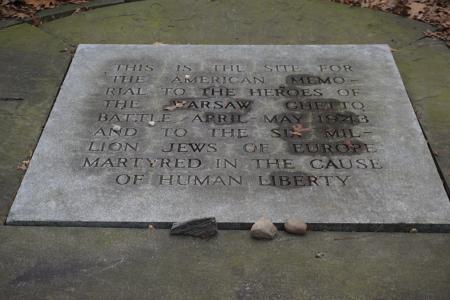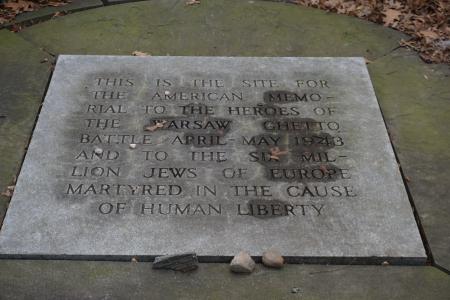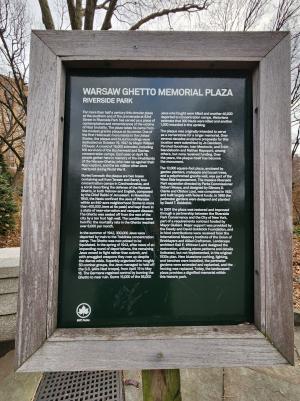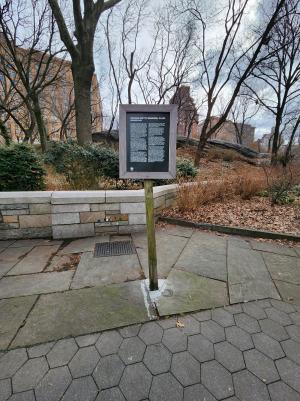Obj. ID: 47080
Modern Jewish Art Warsaw Ghetto Memorial Plaza, Riverside Park, New York, NY, USA, 1947
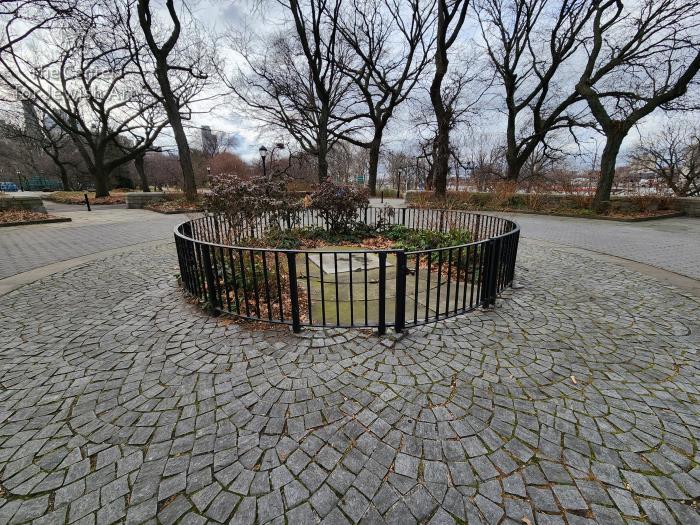
Monument Name
Warsaw Ghetto and Holocaust Memorial
Who is Commemorated?
Warsaw Ghetto Fighters and six million Jews perished in the Holocaust
Description
This 12,000-square-foot circular plaza includes landscaped flora and benches on the perimeter, patterned bluestone walkways, and a fenced-in commemorative plaque made of granite, which itself is surrounded by a crescent of landscaped flora.
The plaque contains a dedicatory inscription, and buried beneath the plaque are two boxes containing soil from Terezin and Sered, as well as a scroll describing the defense of the Warsaw Ghetto, composed by the Chief Rabbi of Jerusalem and written in both Hebrew and English (though this is not visible to visitors).
Along the perimeter of the plaza, one can find a sign bearing a plaque that details the history of the plaza, as well as the story of the Warsaw Ghetto Uprising.
Inscriptions
Dedicatory Plaque:
This is the site for
the American memo-
rial to the heroes of
The Warsaw Ghetto
Battle April - May 1943
and to the Six Mil-
lion Jews of Europe
martyred in the cause
of human liberty
Explanatory Plaque:
For more than half a century this circular plaza
at the southern end of the promenade at 83rd
Street in Riverside Park has served as a place of
contemplation and remembrance of the victims
of Nazi brutality. The plaza takes its name from
the modest granite plaque at its center. One of
the first Holocaust monuments in the United
States, the plaque and its surroundings were
dedicated on October 19, 1947 by Mayor William
O'Dwyer. A crowd of 15,000 attended, including
100 survivors of the Buchenwald and Dachau
concentration camps. Each year on April 19,
people gather here in memory of the inhabitants
of the Warsaw Ghetto, who rose up against their
Nazi Captors, and the six million other Jews
martyred during World War II.
Buried beneath the plaque are two boxes
containing soil from Terezin and Sered, two
concentration camps in Czechoslovakia, and
a scroll describing the defense of the Warsaw
Ghetto, in both Hebrew and English, composed
by the Chief Rabbi of Jerusalem. In November
1940, the Nazis confined the Jews of Warsaw
within an 840-acre neighborhood (home to more
than 400,000 Jews at its peak) and kept them in
a state of near-starvation and rampant disease.
The Ghetto was sealed off from the rest of the
city by a ten foot high wall. The conditions were
horrific: the mortality rate in the Ghetto reached
over 6,000 per month.
In the summer of 1942, 300,000 Jews were
deported by train to the Treblinka concentration
camp. The Ghetto was now poised to be
liquidated. In the spring of 1943, after news of an
impending round of deportations, the remaining
Jews vowed to fight rather than submit, and
with smuggled weapons they rose up despite
the dismal odds. Superbly organized into roughly
50 combat groups, the Jews managed to hold off
the s.s. (elite Nazi troops), from April 19 to May
16. The Germans regained control by burning the
Ghetto to near ruin. Some 15,000 of the 56,000
Jews who fought were killed and another 40,000
deported to concentration camps. Historians
estimate that 300 Nazis were killed and another
1,000 wounded in the uprising.
The plaque was originally intended to serve
as a cornerstone for a larger memorial. Over
several decades sculpture proposals for this
location were submitted by Jo Davidson,
Percival Goodman, Ivan Mestrovic, and Erich
Mendelson and Nathan Rapoport, among
others, but none received funding. Over
the years, the plaque itself has become
the monument.
The 12,000 square-foot plaza, enclosed by
garden planters, crabapple and locust trees,
and a polychrome granite wall, was part of the
West Side Improvement. The massive Riverside
Park expansion directed by Parks Commissioner
Robert Moses, and designed by Gilmore D.
Clarks and Clinton Loyd, was completed in 1937,
and built largely with federal funds. In 1990 the
perimeter gardens were designed and planted
by David T. Goldstick.
In 2001 the plaza was restored and improved
through a partnership between the Riverside
Park Conservancy and the City of New York,
part of a requirements contract funded by
Mayor Giuliani. Major Support was provided by
the Deedy and David Goldstick Foundation, and
in-kind contributions were received from the
International Masonry Institute of the Union of
Bricklayers and Allied Craftsmen. Landscape
architect Gall E. Wittwer-Laird designed the
restoration, utilizing stone patterns and details
indicated, but not implemented, in the original
1930s plan. New bluestone curbing, lighting,
and benches were installed, the perimeter
gardens were extended and replanted, and the
fencing was replaced. Today the landscaped
plaza provides a dignified memorial within
this historic park.
sub-set tree:
| West 83rd Street New York, NY 10024
Bluestone
Trees (Crabapple and Locust)
Assorted flora
One of the first Holocaust monuments in the United States, the plaque and its surroundings were dedicated on October 19, 1947, by Mayor William O'Dwyer.
The 12,000 square-foot plaza, enclosed by garden planters, crabapple and locust trees, and a polychrome granite wall, was part of the West Side Improvement. The Riverside Park expansion directed by Parks Commissioner Robert Moses, and designed by Gilmore D. Clarks and Clinton Loyd, was completed in 1937 and built largely with federal funds. In 1990 the perimeter gardens were designed and planted by David T. Goldstick.
The plaque was initially intended to serve as a cornerstone for a larger memorial. Over several decades sculpture proposals for this location were submitted by Jo Davidson, Percival Goodman, Ivan Mestrovic, Erich Mendelson, and Nathan Rapoport, but none received funding. Over the years, the plaque itself has become the monument.
In 2001 the plaza was restored and improved through a partnership between the Riverside Park Conservancy and the City of New York, part of a requirements contract funded by Mayor Giuliani.
Every year on April 19, on the anniversary of the Warsaw Ghetto Uprising a ceremony is held in Riverside Park at the plaza honoring the victims of the uprising
"American Memorial to Six Million Jews of Europe," Wikipedia, https://en.wikipedia.org/wiki/American_Memorial_to_Six_Million_Jews_of_Europe (accessed January 25, 2023)




